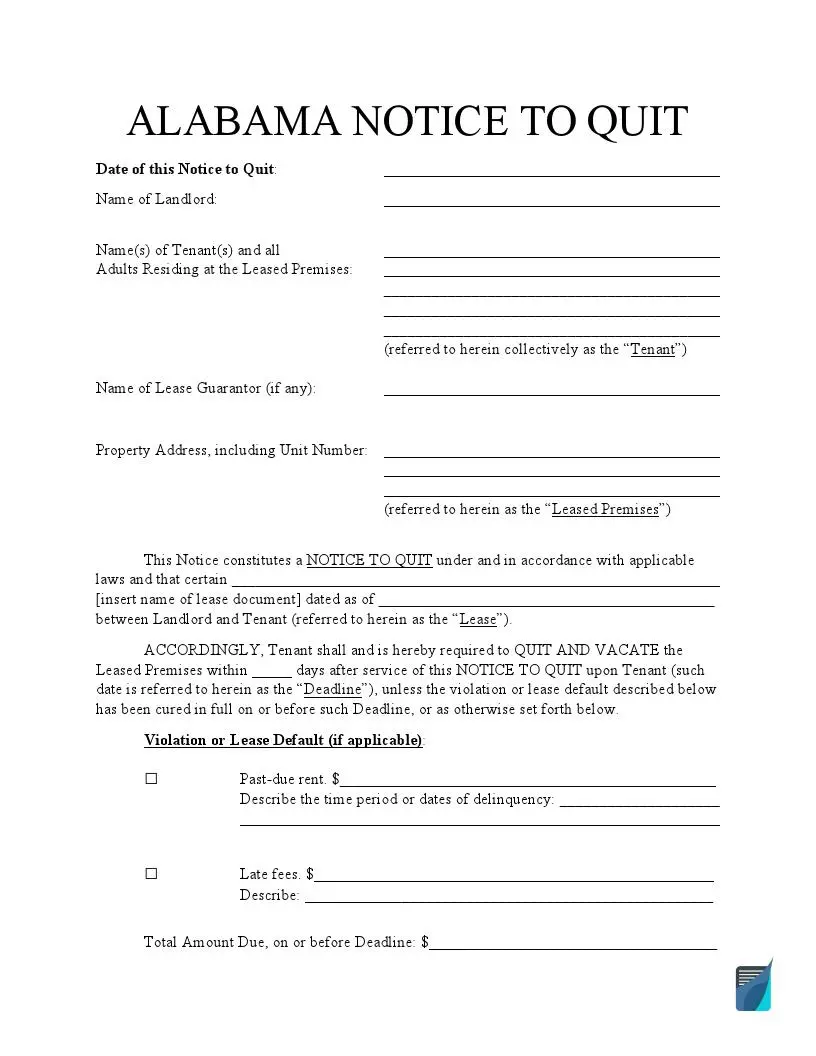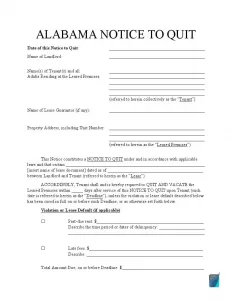Alabama Eviction Notice Forms
Alabama introduces many layers of protection for landlord-tenant relations regulated by §35-9A of the Alabama Uniform Residential Landlord and Tenant Act. An Eviction Notice or Letter to Quit appears to be one of these measures.
Alabama eviction notice templates regulate and cure violations performed on the tenant’s part towards the landlord, the terms of the lease agreement, or the residence the lessee rents. Under these circumstances, the property owner has a legal right to notify their tenants to vacate the dwelling territories, alternatively to fixing the fault.
Relying on the type of lease and conditions of the contract, tenants obtain different deadlines to satisfy the landlord’s demands. The most evident and popular reason to draw up an eviction notice form in Alabama is the lessee’s incompetence to pay the rent due to financial straits or personal reluctance. However, there are other essential reasons for creating a letter to quit types that we will cover in further sections of this review.

Build Your Document
Answer a few simple questions to make your document in minutes
Save and Print
Save progress and finish on any device, download and print anytime
Sign and Use
Your valid, lawyer-approved document is ready
Alabama Eviction Laws
Once a landlord decides to terminate a lease and make the tenants leave the dwelling or commercial unit, he or she must strictly follow Alabama laws. Suppose a property owner is executing the matter going by their wishes that do not meet the demands of the state laws. The tenants have a legal right to refuse to vacate the rented space and even draw up a lawsuit against the landlord.
Relevant documentation and legitimate actions are the keys to success with lease eviction. Below you will find the list of requirements that can validate the landlord’s actions and protect tenants from illegal behavior.
- Failure to Rent
Following §35-9A-421 of Alabama Uniform Residential Landlord and Tenant Act, tenants obtain seven days after the eviction letter to cure the trouble, fulfill rental payment in full amount or leave the premises.
- Rent Grace Period
35-9A-161 of Alabama Act states that a landlord doesn’t need to delay an eviction notice for a particular period after not getting the rent. The premises owner has the legal power to draw up the letter immediately.
- Noncompliance
Lease violation issues are covered in §35-9A-421 and state that a lessee is granted seven days to atone the negligence or depart from the dwelling unit.
- Termination of Month-to-Month Lease
When a landlord decides to terminate the lease via the eviction notice in Alabama, he or she must grant the lessee 30 days to leave the residence and find a new rental unit. Find more details in §35-9A-441 of the corresponding Act.
It is vital for both parties to follow Alabama laws, as the attitude may result in future lease options. Disobedience may lead to court matters.
Alabama Eviction Notice Laws Details
| Rent Grace Period | None |
| Notice of Non-Payment | 7 days |
| Notice of Non-Compliance | 7 days |
| State Laws | Alabama Code, Section 35-9A, Article 4 |
Eviction Notice Types Used in Alabama
Relying on the goal for creating an eviction notice, Alabama recognizes several types of the letter to quit.
7-day Notice of Eviction of Lease (Nonconformity)
The template allows notifying the lessee of the violated terms of the rental agreement and provides reasons for issuing the eviction notice. Compared to a Non-Payment eviction letter, nonconformity covers serious regular violations, including drug abuse, criminal assault of other persons on the territory of rental property. The landlord offers seven days to depart from the dwelling unit.
7-day Eviction Notice to Quit
The form is otherwise known as the Alabama Termination of Tenancy for Non-Payment of Rent. If your tenant fails to provide rent payment, you are empowered to create a letter, granting seven days to cure the trouble or leave the residence.
Notice of Termination of Month-to-Month Tenancy
This eviction template will require a 30-day deadline to vacate the residence. This eviction template shares information about canceling the lease by the upcoming month. Thus, tenants are granted 30 days to collect necessary documentation and find a new dwelling or commercial unit.

Eviction Process in Alabama
Issuing an Alabama Eviction Notice, just like any legal procedure, demands precise execution and much attention. The state of Alabama highly recommends that the parties follow the Uniform Residential Landlord and Tenant Act.
Otherwise, the violating party will lack legal support and experience trouble filing a lawsuit in court. Use the below-listed guidelines to gain the best result.
- Generate the Template
Choose one of the three templates relying on the reasons for your decision and generate a document. To achieve success, you are empowered to use our form-building software.
- Complete and Authorize the Document
Define your identification, the address of the rental unit, and the reasons for creating the eviction notice. Depending on the type of the template, you’ll need to specify this or that information. Follow the requirements of the particular form.
- Serve the Eviction Letter
When the document is ready, the time comes to send it to your tenants. We recommend using reliable certified mail providers, private services, or sheriff assistance.
Why is it vitally important? Proof of service is your evidence that the recipient has obtained the notice. The tenant should provide a signature that he or she has been notified. When providing these conditions, the landlord cannot be accused of retaliatory actions, motiveless evictions, discriminatory behavior, or unreasonable rent without notifications.
- Define Further Policy
By the time of the deadline specified in the eviction notice, the tenant must either pay the debt or leave the rented residence. If neither happens, the landlord obtains the legal power to file a lawsuit against the lessee in court.
The following steps will provide recommendations in the event that the tenant fails to satisfy the previous demands.
- Notify the Tenant of the Court Issues
To generate a letter, you opt to turn to the Sheriff’s Office. The tenant is granted a week to complete and file the answer.
You can read the list or related documentation in the last section of this review.
- Complete the Court Issues
Both the lessor and the lessee must appear at court on the appointed date. The authorized persons will deliver judgment.
Alabama Eviction Court Forms
Beneath there are essential documents that a landlord will need while filing a lawsuit with a Court.
- State of Claim (Eviction or Unlawful Detainer)
This letter is completed by the property owner to begin the proceedings. The next step will cover notifying the tenant about the upcoming procedures.
- Answer Form PS-01
The document is filled out by the tenant. The lessee should provide this form at court not later than seven days after he or she obtained a State of Claim notification.

Use our document builder to customize any template on FormsPal to your preferences. Here is a number of some other widely-used Alabama forms we provide.
